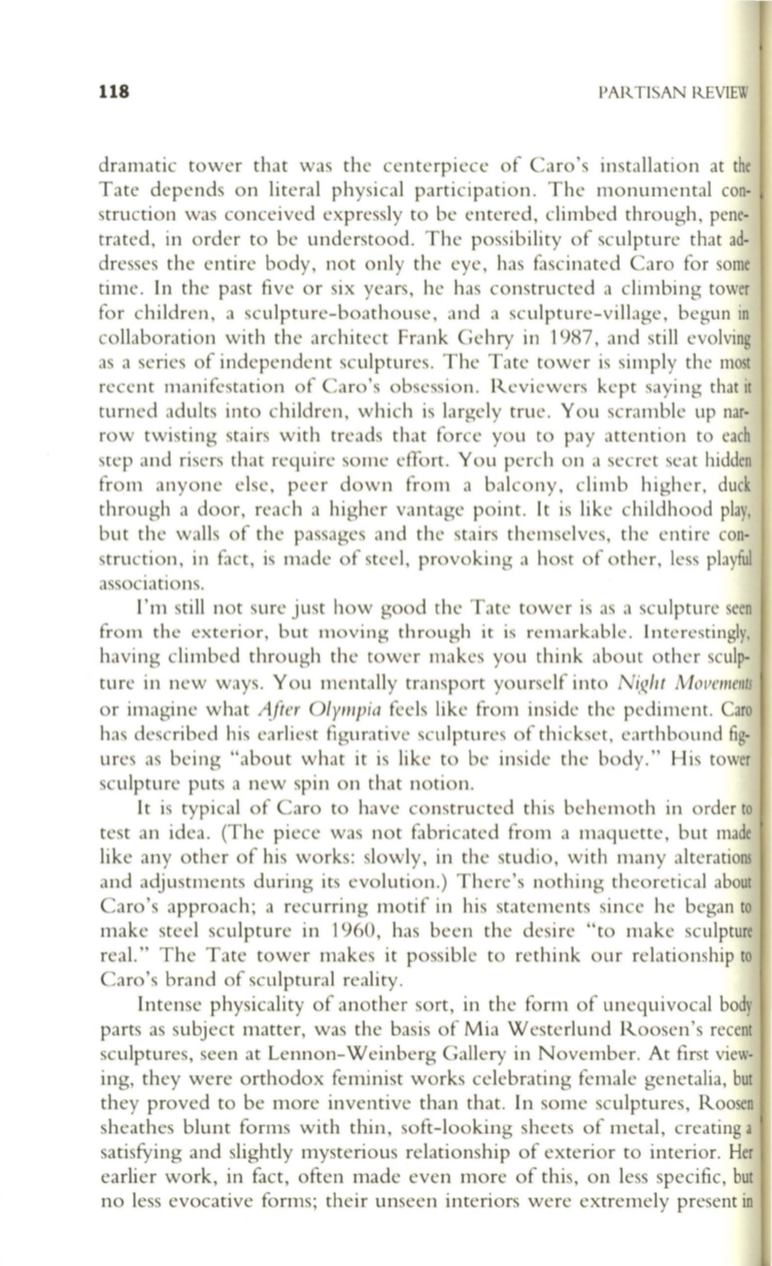
118
PARTISAN REVIEW
dramatic tower that was the centerpiece of Caro's installation at the
Tate depends on literal physical participation. The monumental con-
I
struction was conceived expressly to be entered, climbed through , pene–
trated, in order to be understood. The possibility of sculpture that ad–
dresses the entire body, not only the eye, has fascinated Caro for some
time . In the past five or six years, he has constructed a climbing tower
for children, a sculpture-boathouse, and a sculpture-village, begun in
collaboration with the architect Frank Gehry in 1987, and still evolving
as a series of independent sculptures. The Tate tower is simply the most
recent manifestation of Caro's obsession. Reviewers kept saying that it
turned adults into children, which is largely true. You scramble up nar–
row twisting stairs with treads that force you to pay attention to each
step and risers that require some effort. You perch on a secret seat hidden
from anyone else, peer down from a balcony, climb higher, duck
through a door, reach a higher vantage point. It is like childhood play,
but the walls of the passages and the stairs themselves, the entire con–
struction, in fact, is made of steel, provoking a host of other, less playful
assoCiations.
I'm still not sure just how good the Tate tower is as a sculpture seen
from the exterior, but moving through it is remarkable. Interestingly,
having climbed through the tower makes you think about other sculp–
ture in new ways. You mentally transport yourself into
Night Movements
or imagine what
After Olympia
feels like from inside the pediment. Caro
has described his earliest figurative sculptures of thickset, earthbound fig–
ures as being "about what it is like to be inside the body." His tower
sculpture puts a new spin on that notion .
It is typical of Caro to have constructed this behemoth in order to
test an idea. (The piece was not fabricated from a maquette, but made
like any other of his works: slowly, in the studio, with many alterations
and adjustments during its evolution.) There 's nothing theoretical about
Caro's approach; a recurring motif in his statements since he began to
make steel sculpture in 1960, has been the desire "to make sculpture
real." The Tate tower makes it possible to rethink our relationship to
Caro's brand of sculptural reality.
Intense physicality of another sort, in the form of unequivocal body
parts as subject matter, was the basis of Mia Westerlund Roosen's recent
sculptures, seen at Lennon-Weinberg Gallery in November. At first view–
ing, they were orthodox feminist works celebrating female genetalia, but
they proved to be more inventive than that. In some sculptures, Roosen
sheathes blunt forms with thin, soft-looking sheets of metal, creating a
satisfying and slightly mysterious relationship of exterior to interior. Her
earlier work, in fact, often made even more of this, on less specific, but
no less evocative forms; their unseen interiors were extremely present in


